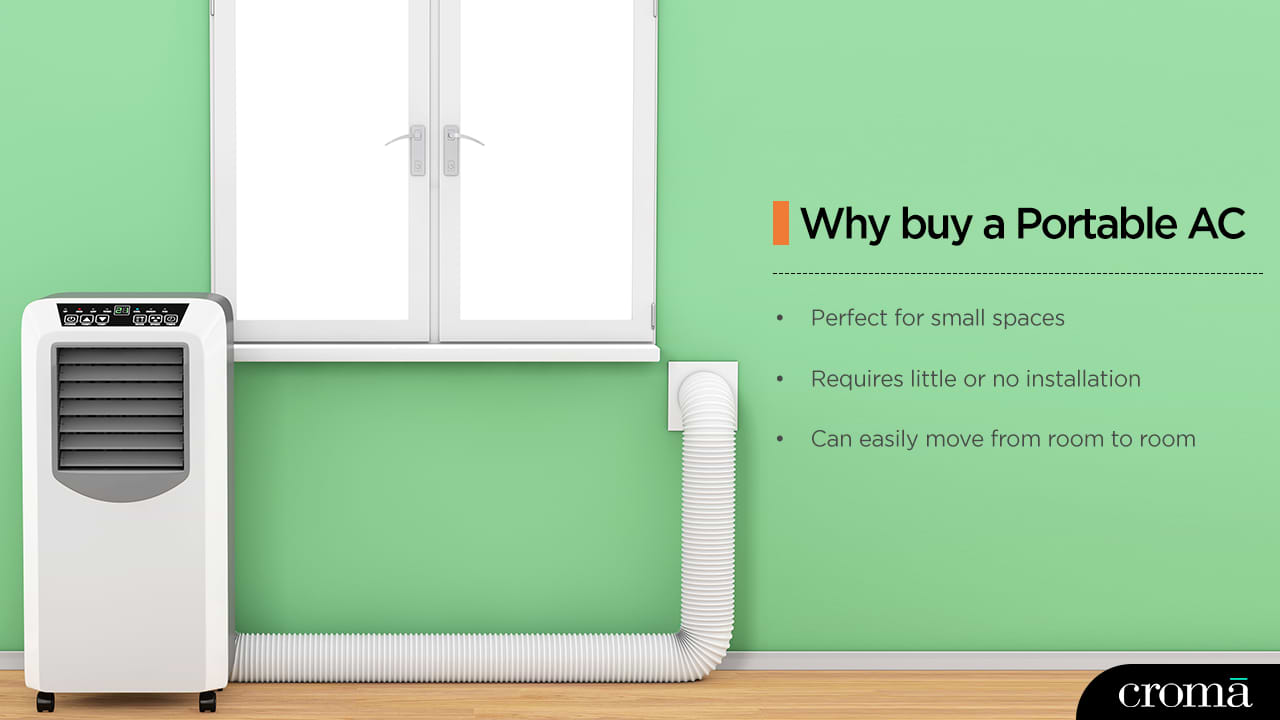Portable Air Conditioners, also known as Portable ACs, allow for much more flexibility than a typical window or split AC. As the name suggests, a portable AC can be moved around easily, and it’s possible to use the same appliance in different rooms of your home with minimal effort; you can just pick it up and place it wherever you need it. But exactly how does a portable air conditioner work, though?
How does a portable AC work?
For all practical purposes, a portable AC is much like a Window or Split AC, using an evaporator coil, condenser coil, compressor, and fan to cool the air. However, the form factor of a portable air conditioner is different, as it is a self-contained and entirely portable unit, unlike a window AC or split AC which needs to be mounted on a window or outside facing wall, and have the split unit separately installed in an outside area.
The way an air conditioner functions requires for warm air to be exhausted, and it’s no different with a portable AC. You’ll need to attach the included hose pipe to the rear of the portable AC, which will carry moisture and heat out of the room. You will therefore have to be careful with installation and setup, as you’ll need to have a way to channel the hose to dump heat and moisture outside.
ALSO READ: AC installation: What to expect and what is included in the cost?
Once properly set up, a portable AC can cool and recirculate cool air in the room the same as a window AC or Split AC and are generally as energy-efficient as well. This also includes the need for regular servicing, as well as periodically ensuring that the AC gas is topped up to ensure the appliance is able to continue cooling efficiently.
Despite the similarities in form and the ability to move the device around, a portable AC is different from an air cooler. The former functions the same as an AC and uses a complex process to more effectively cool air in a closed space without the need for water, while an air cooler uses large quantities of water for the cooling process, and works best with fresh air.

Advantages of a portable AC
Depending on the design, a portable AC can either be light enough to lift and carry or can be rolled around from room to room on wheels. You can therefore use the same air conditioner in different rooms of your home as needed, thus saving on the cost of buying multiple air conditioners for different rooms, and the hassles of fixed installation that come with window or split ACs.
Another key advantage of owning a portable AC is the ease of setup and installation. Since the device is an independent unit, it simply needs to be plugged in to use, with the exhaust pipe channelled outside through a small gap or window.
ALSO READ: Air Conditioner vs Air Cooler: What should you get?
This can come in handy in homes where installation is tricky, and some models are designed to be narrow and tower-like, thus being able to be positioned conveniently in the corner of a room. The vents can also thus be positioned closer and more conveniently towards the user, thus promising more effective and targeted cooling.
Should I buy a portable AC?
Under certain circumstances, a portable AC might be more suited to you than a window or split AC. It’s worth considering if you want to use a single unit in different rooms, or are unable to install a regular window or split AC due to technical or architectural issues. Do keep in mind that a portable AC requires a high-amperage power socket to run, and you will need to ensure that the hose pipe is able to exhaust the heat and moisture properly, to ensure efficient functioning.
Unleash your inner geek with Croma Unboxed
Subscribe now to stay ahead with the latest articles and updates
You are almost there
Enter your details to subscribe

Happiness unboxed!
Thank you for subscribing to our blog.
Disclaimer: This post as well as the layout and design on this website are protected under Indian intellectual property laws, including the Copyright Act, 1957 and the Trade Marks Act, 1999 and is the property of Infiniti Retail Limited (Croma). Using, copying (in full or in part), adapting or altering this post or any other material from Croma’s website is expressly prohibited without prior written permission from Croma. For permission to use the content on the Croma’s website, please connect on contactunboxed@croma.com
- Related articles
- Popular articles












Ali Pardiwala
Comments